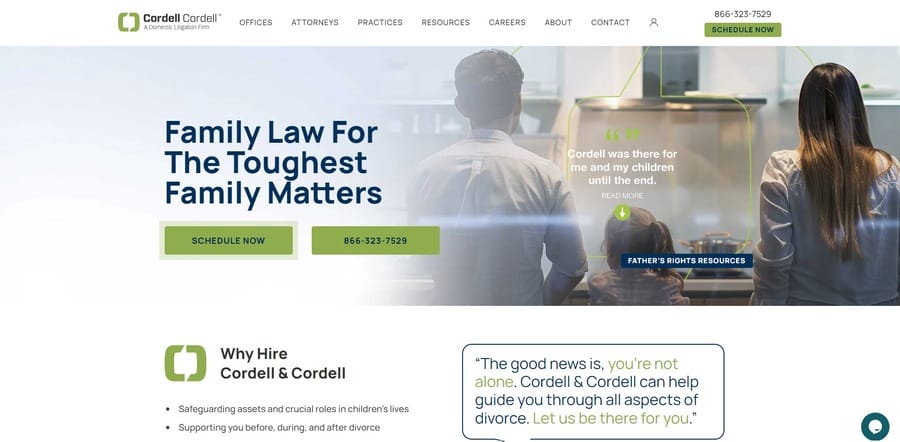Digital Marketing Strategy For Law Firms: Key Highlights
-
Data-driven marketing fuels growth: Outsourcing and clear goals boost visibility, lower acquisition costs and secure better rankings.
-
Targeting ideal clients drives better results: Precise client profiles focus campaigns on high-value cases that match firm expertise.
-
Strong digital foundations win leads: Professional websites, trust signals and local SEO turn online searches into consultations.
When legal trouble strikes, prospects reach for Google before they reach for you.
Recognizing the stakes, 83% of law firms outsource their marketing to keep attorneys focused on billable work and courtroom wins.
This approach allows for rigorous, data-driven campaign management that amplifies brand awareness and reputation, prioritizes compliance and supports predictable revenue.
In this post, we’ll explore proven steps to creating a digital marketing strategy for law firms that attracts qualified leads, establishes your legal expertise and grows your practice’s client base.
- What this guide delivers: A three-step, ROI-driven blueprint that shows managing partners exactly where to direct budget, how to measure CAC-to-LTV and which 2025 tactics protect compliance while filling the pipeline.
- Proof it works: Digital Silk’s legal clients multiplied organic visits by 14, tripled the site’s domain authority and earned first-page Google positions for ten high-value keywords.
Step 1. Define Your Law Firm’s Marketing Goals
Digital marketing for legal firms starts with knowing exactly what you want to achieve.
Before selecting platforms or tactics, you need to establish precisely what success looks like for your law practice.
Below, we’ll explore how to set meaningful objectives and identify your ideal clients to build a marketing strategy that drives real growth for your firm.
1. Set Clear Business Objectives
74% of marketers say they set specific marketing goals, yet only 49% of them manage to achieve them.
That gap reveals a simple truth — writing a goal is easy but achieving it requires a framework that locks accountability to measurable outcomes.
Your marketing plan needs SMART goals — Specific, Measurable, Achievable, Relevant and Time-bound objectives that align with your practice’s vision to close that execution gap.
Instead of simply aiming to “get more clients,” define precise targets like:
- Lead generation goals: Determine exactly how many qualified leads you need monthly through your website, social media, or email campaigns
- Client acquisition targets: Specify the number of new clients you want to convert quarterly from your marketing efforts
- Revenue objectives: Calculate the expected return on investment from specific marketing channels
- Brand awareness metrics: Establish measurable goals for increasing your firm’s visibility in your practice area
For example, rather than “improving your website,” set a specific goal like increasing website consultation requests from 15 to 30 per month within six months through targeted content and strategic call-to-action placement.
Your marketing objectives should directly support broader business goals.
If your practice aims to expand into corporate law from family law, your marketing strategy should specifically target business owners and entrepreneurs in your area.
2. Identify Your Ideal Client Profile
Only 42% of marketers have definitive data on their target audience or buyer personas to guide their strategies.
This oversight can directly affect your firm’s ability to attract the right clients.
Client personas are semi-fictional representations of your ideal clients that help focus your marketing efforts where they’ll yield the best results.
You can create these profiles by analyzing your current client base:
- Which clients bring the most value to your firm?
- Which cases align best with your expertise and interests?
- What common characteristics do your best clients share?
Your client profile should include these key elements:
- Demographic information: Age, income level, profession, education
- Psychographic details: Values, priorities and pain points related to legal issues
- Common legal needs: Specific situations that trigger the need for your services
- Decision-making factors: What influences their choice when hiring an attorney
- Preferred communication: How and where they search for legal information
Different practice areas demand different targeting approaches.
For instance, estate planning attorneys might focus on older, affluent individuals concerned about legacy, while personal injury lawyers may target broader demographics with specific injury situations.
When your personas are clearly defined, you can craft compelling messages that address specific challenges.
For example, if your ideal clients are small business owners worried about liability, your content should directly address those concerns with practical protection strategies.
By establishing clear business objectives and identifying precisely who you want to reach, you create the foundation for a focused, effective marketing strategy — one that attracts the right clients rather than just any clients.
Take Cordell & Cordell as an example — the company positions itself as the go-to domestic-litigation firm for fathers and husbands, pledging “Family Law for the Toughest Family Matters.”
The firm’s core messaging reinforces that promise — offering men-focused divorce resources, custody-rights guides and a commitment to “level the playing field” in high-conflict cases.

Step 2. Research Your Market And Competitors
Building a distinctive digital strategy for your law practice requires deep market understanding and competitive intelligence.
Thorough analysis reveals opportunities your competitors have missed while positioning your firm for strategic growth.
1. Analyze Competing Law Firm Marketing Campaigns
With over 463,000 law-firm businesses operating in the United States, even niche practice areas face abundant alternatives in a single Google results page.
Examining what your competitors do well — and where they fall short — provides valuable insights without costly trial and error.
Select 5-10 competing firms in your practice area and location, then evaluate their:
- Website design, structure and content quality
- Social media engagement and posting frequency
- Email marketing approaches (subscribe to their newsletters)
- Content strategy (including blog topics and publishing cadence)
- Client testimonials and review management
This competitive analysis helps identify market gaps your firm can fill while answering practical questions about optimal content length and publishing frequency.
Moreover, conducting a SWOT analysis (Strengths, Weaknesses, Opportunities, Threats) for each competitor reveals where your practice can excel and where improvements are necessary.
Pay particular attention to how competitors position themselves through client demographics, pricing strategies and unique selling propositions.
These insights help your firm develop meaningful differentiation in a crowded legal marketplace.
2. Use Keyword Tools To Find Search Demand
Organic search for legal services converts at an average rate of 4.2%, making it one of the highest-performing channels for law-firm lead generation.
But to capture that traffic, you need to know exactly what your potential clients are searching for — and that starts with strategic keyword research.
You can capitalize on this search traffic by using these powerful keyword research tools:
- SEMrush: Analyze competitor URLs to uncover which keywords are driving their traffic.
- Google Keyword Planner: Access search volume and related terms straight from Google.
- AnswerThePublic: Discover what questions potential clients are asking about your services.
Focus on three high-converting keyword types:
- Local keywords that include your city or geographic area
- Long-tail keywords (specific phrases like “real estate law firm near me free consultation”)
- Practice-specific terms related to your firm’s specialties
These targeted keywords typically convert better than broad, highly competitive terms.
For tracking purposes, export your keyword data into a spreadsheet to monitor search volume, competition level and relevance to your practice.
3. Study Client Behavior And Search Intent
Understanding why potential clients search for legal services significantly improves your marketing effectiveness.
Search intent falls into four main categories:
- Informational: Looking for legal information (how-to guides, explanations)
- Navigational: Seeking a specific law firm or attorney website
- Transactional: Ready to hire a lawyer (includes terms like “hire” or “consultation”)
- Commercial investigation: Researching options (“best family law attorneys in Chicago“)
While Google uses over 200 factors to rank results, one of them focuses on delivering content that matches the user’s intent.
To optimize for search intent, analyze the modifiers in search queries — words like “best”, “near me”, “how to”, or “hire”— which signal the searcher’s purpose.
Then, structure your content to address these specific needs at each stage of the client journey.
Through thorough market and competitor research, you’ll build a data-driven digital marketing strategy that positions your law firm for success against larger, more established competitors.
Step 3. Build Your Digital Marketing Foundation
Building strong digital assets serves as the backbone of sustainable client acquisition for legal practices of all sizes.
Below, we’ll explore the key law firm marketing tips that boost visibility, establish credibility and convert website visitors into paying clients.
1. Create A Professional Website For Attorneys
94% of law firms have a dedicated website and 78.2% of professionals actively use it to promote their services.
Your website functions as a 24/7 digital representative for your practice — the first impression most potential clients will have of your firm.
Since 75% of website visitors judge a company’s credibility based on its design, clients often form an opinion on your expertise long before making that first call.
You can create an effective attorney website by focusing on these core elements:
- User experience: Structure your site with intuitive navigation so visitors can easily find what they need.
- Clear service descriptions: Explicitly outline your legal services and their specific benefits to clients.
- Clear contact information: Display phone numbers, email addresses and office locations prominently with multiple calls-to-action.
- Client intake options: Add online forms and scheduling tools so prospects can begin the process immediately.
- Mobile optimization: Ensure your site performs flawlessly on smartphones, as mobile devices now drive 64.04% of all web traffic.
- Use appropriate visuals: Original, high-quality images enhance your brand perception significantly more than stock photos.
For instance, Walters Gilbreath, PLLC‘s website features a minimalist design with a clean white and gold color scheme, intuitive navigation and strategically placed calls to action like “Request a Consultation.”
The site includes detailed attorney bios and useful client resources such as blogs and podcasts, all optimized for mobile devices.

2. Showcase Trust Badges And Social Proof
Showcasing trust badges and social proof is a powerful marketing strategy for law firms aiming to build credibility and convert website visitors into clients.
Trust badges — such as bar association memberships, legal certifications and industry awards — serve as visual endorsements of a firm’s qualifications and professionalism.
Social proof, including client testimonials and case studies, provides real-world evidence of a firm’s success and client satisfaction.
For instance, Morgan & Morgan regularly features real clients in YouTube videos, where they speak candidly about their legal experiences and outcomes.
These testimonials help prospective clients see exactly how the firm has delivered results for people in similar situations.
3. Set Up Google Business Profile And Directories
68% of online experiences begin with a search engine.
Optimizing your Google Business Profile (GBP) makes it substantially easier for nearby clients to find you when they need legal help.
When creating your GBP, select specific categories like “Personal Injury Attorney” rather than the generic “Law Firm” label.
Ensure your name, address and phone number (NAP) remain consistent across all platforms and use a local phone number instead of toll-free options to strengthen local relevance.
After verification, post regular updates to your profile. This signals to Google that you’re an active business in your community, which can improve your visibility in local search results.
Additionally, claim your listings on legal directories like Martindale or Avvo to generate valuable backlinks while expanding your firm’s digital footprint.
4. Establish A Strategic Social Media Presence
While 81% of firms maintain some social media presence, quality matters significantly more than quantity.
Choose platforms based on your practice area rather than trying to maintain a presence everywhere.
LinkedIn remains the most popular platform among lawyers, while Facebook and X (formerly Twitter) follow behind.
When developing your social media strategy, consider these key factors:
- Review your jurisdiction’s ethics rules before developing your posting strategy
- Focus on 2-3 platforms where your ideal clients are most likely to engage
- Create a consistent posting schedule to maintain visibility and engagement
Through strategic implementation of these foundational elements, you create the digital infrastructure needed to attract qualified leads and convert them into clients for your practice.
For instance, Kirkland & Ellis posts on LinkedIn almost every day, sharing updates on recent client deals, quick takes on new ESG rules and behind-the-scenes stories about its lawyers.
Digital Silk’s Law Firm Marketing Examples

Digital Silk created a research-driven SEO strategy for the Law Offices of Spar & Bernstein, starting with an audit that uncovered high-value immigration and personal injury keywords and untapped content gaps.
We paired authority-building articles with technical upgrades — faster load times, cleaner site architecture, and structured data — to signal relevance and trust to search engines.
In just six months the strategy produced a 14-fold jump in organic traffic, tripled domain authority and captured ten top-10 rankings for “immigration lawyer”, “refugee lawyer” and other critical terms.
How To Choose The Right Marketing Channel For Your Law Firm
After building your digital foundation, you need to select a marketing channel that delivers optimal results for your specific practice.
Strategic channel selection ensures your marketing budget generates maximum ROI while connecting with potential clients at every stage of their decision-making journey.
Below, we’ll explore the four most effective digital marketing channels for law firms and how each one supports different aspects of your client acquisition strategy.
1. SEO For Long-Term Visibility
57% of consumers look for legal representation online, which makes search engine optimization a cornerstone of sustainable client acquisition for law firms.
While SEO takes time to show results, it can deliver lasting visibility and a steady flow of qualified leads, which turns it into one of the most valuable long-term investments for growing your practice.
You can improve your rankings by:
- Creating keyword-optimized content that addresses specific client questions
- Building quality backlinks from reputable legal directories and publications
- Ensuring technical elements like site speed and mobile friendliness meet Google’s standards
2. PPC For Immediate Lead Generation
Unlike SEO’s long-term approach, Pay-Per-Click advertising delivers immediate visibility.
PPC ads appear at the very top of search results as prime digital real estate for capturing high-intent prospects.
While the average cost-per-click for legal keywords is the highest at $8.94, the investment often yields excellent returns because PPC captures user intent precisely when potential clients need legal help.
3. Email Marketing For Client Retention
Email marketing offers an impressive 3,600% ROI — averaging $36 for every $1 spent.
This channel primarily helps nurture relationships with current and former clients through personalized communications.
Effective legal email marketing:
- Delivers tailored messages addressing specific client concerns
- Maintains your firm’s visibility between legal matters
- Educates clients about relevant legal developments and changes
- Promotes referral opportunities from satisfied former clients
4. Content Marketing For Trust Building
83% of marketers cite content marketing as the most effective strategy for demand generation.
By regularly publishing valuable articles, videos and resources, you position your firm as a thought leader in your industry and an authoritative choice when legal needs arise.
Some effective content formats for law firms include:
- Practice area guides explaining complex legal concepts in clear language
- Case studies highlighting successful client outcomes (with appropriate anonymization)
- FAQ pages addressing common legal concerns in your specialty
- Video explanations of legal processes and client journeys
The best content marketing strategy addresses the questions potential clients ask before they even contact an attorney, establishing your expertise early in their decision process.
| Channel | Strengths | When To Use |
| SEO | Long-term visibility | Brand building and lower long-term CAC |
| PPC | Immediate lead generation | Fast results or new practice launches |
| Retention and referrals | Nurture relationships and drive engagement | |
| Content | Trust and education | Growth-oriented authority building |
How To Track And Improve Your Law Firm Marketing Campaigns
What gets measured gets managed. For law firms investing in digital marketing, tracking performance isn’t optional — it’s essential for sustainable growth.
Data-driven marketing identifies which campaigns deliver genuine value and which need refinement or elimination.
This analytical approach helps you allocate resources effectively while maximizing your return on investment.
1. Use Analytics To Monitor Performance
Setting up Google Analytics or Search Console for your website creates the foundation for effective decision-making in your firm’s marketing strategy.
This powerful tool shows you exactly:
- Which websites visitors came from before reaching yours
- How long users stayed on specific pages
- Which pages generate the most engagement
- What content drives potential clients to contact you
For comprehensive tracking, establish clear key performance indicators (KPIs) that align with your firm’s objectives:
- Website traffic and referral sources
- Conversion rates for contact forms and consultations
- Cost per lead and client acquisition costs
- Return on investment for each marketing channel
2. Adjust Campaigns Based On Data
After collecting 3-6 months of performance data, you can identify patterns that reveal both strengths and weaknesses in your marketing approach.
Review underperforming tactics and reallocate resources toward channels delivering better results.
This process empowers your firm to make strategic adjustments based on evidence rather than intuition or tradition.
A/B testing provides another powerful optimization method that compares different elements in your campaigns — such as:
- Ad headlines and copy variations
- Landing page layouts and content
- Call-to-action button text and placement
- Visual elements and attorney imagery
3. Set Up Monthly Review Checkpoints
Schedule structured review meetings (monthly or quarterly) to assess your measurement plan and identify necessary adjustments.
These regular reviews serve as crucial checkpoints to evaluate marketing performance trends rather than reacting to isolated anomalies.
During these sessions, examine both objective data and subjective feedback from key attorneys.
Law firms that establish this rhythm of reviewing, adjusting and implementing changes maintain marketing effectiveness even as client behaviors and market conditions shift.
Adapting accordingly through continuous assessment allows you to enhance brand visibility, attract qualified leads and maximize conversions.
Creating A Winning Law Firm Digital Marketing Strategy With Digital Silk
Successful law firm marketing isn’t about chasing trends — it’s about making strategic decisions that connect your legal expertise with people who need your services.
Measurable goals, brand-specific personas, relevant keywords and a conversion-optimized site can enhance visibility, credibility and engagement, reinforced by metrics that show exactly how each tactic performs.
Digital Silk’s legal marketing team delivers research-backed, data-driven campaigns that turn that strategy into measurable growth for your legal firm.
As a recognized web design agency, our services include:
- Digital marketing
- Social media marketing
- SEO Services
- PPC Campaigns
- Branding and web design for law firms
Our experts take on a proactive but consultative approach for each project, offering timely updates at every stage of its lifecycle and delivering measurable results.
Need help creating an effective digital marketing strategy for law firms?
Contact our team, call us at (800) 206-9413 or fill in the Request a Quote form below to schedule a consultation.
"*" indicates required fields









